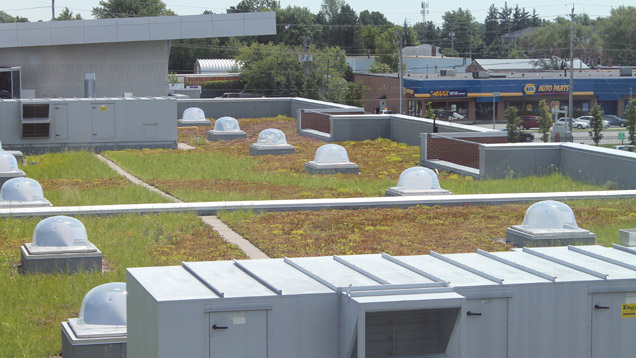Conservation in Z building
 CREDIT: ANDREW VIDLER
CREDIT: ANDREW VIDLERThis is a view of the plant life and GPS skylights on the roof of Z building, some of Fanshawe College's sustainability efforts.
As the ever-growing global warming issue looms over society, new and more effective methods of energy conservation have moved to the forefront of architectural design.
Spearheading the energy conservation efforts at Fanshawe College is the Centre for Applied Transportation Technologies (the Z building), which features a multitude of energy saving features.
The largest — as well as the most visually pleasing of these features is the green roof — a total of 43,000 square feet above the building's auto shops.
The plant life is specifically chosen for their low-maintenance characteristics and ability to absorb water on the flat roof, there are also some modern energy saving features to compliment the roof.
The chief feature among the energy saving techniques is a set of GPS powered skylights. What the skylights do is constantly adjust to the sun's position in order to funnel the maximum amount of natural light into the shop areas.
The skylights are highly effective and a quick walk through the area demonstrates just how little artificial light is needed even when dealing with as large of a space as the repair shop.
Another feature on the roof is a storm water collection system. The system repurposes fallen rainwater in order to recycle it, primarily for the purpose of site irrigation, but it is also used to flush the majority of the building's toilets.
“It's a fantastic system, though some people find it a little strange when their toilet water is grey,” said Mary-Lee Townsend, sustainability co-ordinator at Fanshawe.
Despite its specific, low-maintenance design, the roof does require regular check-ups and in the case of the skylights, the occasional repair or replacement of the computer components.
Fortunately the building is home to the Horticultural Technology program, providing eager and interested students to keep the roof's plant life in top shape.
They also maintain the surrounding grounds, which they have planted fully with native plants and treated with as little chemicals as possible.
In addition to the more visible features, every fan, light switch and heating vent within the Z building is controlled and monitored via a central system.
Each classroom is equipped with an occupancy detecting motion sensor to ensure that energy burning systems are not running in an empty room and negating the chance of the last person out simply forgetting to turn things off.
Even the overhang on the building's front was designed to minimize sun exposure, helping to regulate the use of air conditioning systems in the summer months.
A number of these features will be slowly integrated into other areas of the college in the coming years, but the age of the buildings and the cost of a full upgrade prohibit the rest of the school from reaching Z building's standards.
For the foreseeable future, the Centre for Applied Transportation Technology will be the crown jewel in the college's continued attempts to be a little greener.














